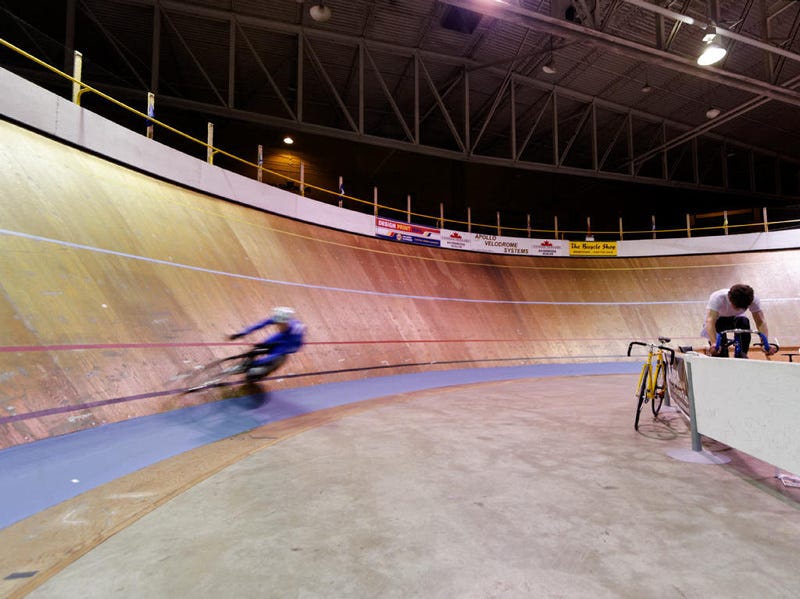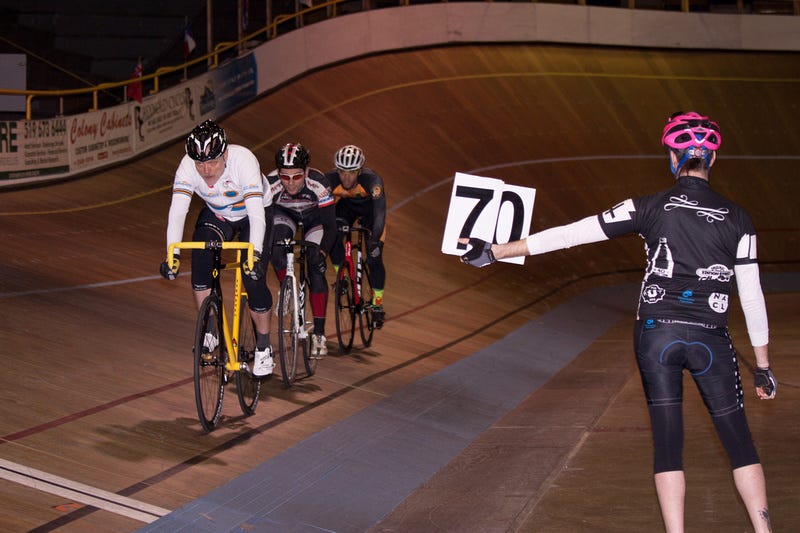Forest City Velodrome, the indoor velodrome in London, Ontario is a gem. The track is, at 138 m, the shortest in the world and, at 52 degrees, also the steepest. It was built in 2005 inside London’s former hockey venue, the London Gardens, after the town’s hockey moved to a new facility. The track is an engineering marvel, with the racing surface extending over the old stadium seating to form the biggest track the building could accommodate
The track size and steepness is extreme but not outrageous. Many of Europe’s pro Six Day races are run on 166 m tracks and the Milan Six on a 150 m. (The difference amounts to just 14 m and 6 m on each straightaway respectively.) FCV’s track has ideal geometry making it delightful to ride. At speeds between 30 and 40 km/h the approach I find works best is to relax and let the physics do the work. At high speed, such as when sprinting, it takes some concentration and positive counter-steer to keep the bike from riding up-track in the turns. At any speed much under 30 km/h the bike will slide off the track.
The turns seem terrifyingly steep to most newcomers. When I first rode here three years ago I was thrown in the deep end. Rob Good, FCV’s Track Director, instructed me to follow my pace rider onto the track in the back straight and accelerate hard so I’d be at a safe speed when I got to turn three. It comes up very quickly and looks like a huge wall. That was daunting.
On January 17 2014 a group of 12 riders, 8 from MIT, one from Yale, one from NYU and two others arrived for three days of training, riding and racing. Prior experience varied. Except for me all were new to FCV. Some had experience on wooden 250 m tracks, others only on larger tracks and three had never been on a track bike before.
Lorne Falkenstein conducted the group through what’s known as Track 1 and Track 2, the introductory training all FCV newcomers have to do. The track is so unusual that even the most experienced need need to adapt. Moreover, in order to maintain safety, FCV has a strict track etiquette that, in some regards, is different from other tracks.
The process Lorne used to get this group up on the boards for the first time and riding around comfortably was brilliantly effective. It was different from my first experience and circumvented the fear of approaching the turn at speed for the first time. Lorne started us riding around on the blue band, increased speed a little at a time, and then told us to let the bike go up-track to the measurement line at the apex of the turns. The bike wants to do this naturally at that speed so you just have to let it and then come back down again onto the blue. Once we were doing that, it was a simple progression to riding around on the track.
After that we practiced the standard procedures for safely entering and exiting the track in traffic, moving around on the track, shoulder checks, riding up and down the banking, pace-lines with lead exchanges, standing, sprinting, passing, communication and eventually racing, including flying lap, kilo, last man standing, scratch race and team pursuit.
There are a number of factors that make Forest City Velodrome extraordinary and wonderful. The track itself is the most obvious. Being so short and steep but with optimal surface geometry it gives the rider more feedback than any other and this makes the riding experience very intense. My enthusiasm for cycling is largely because I enjoy the sensations of riding and FCV amplifies these feelings.
The track demands more control and skill than others. Riding it fast requires excellent control but control at speed in this track needs skill. It thus challenges to the rider, testing her or him and giving immediate feedback, critical or positive, to anyone who cares to pay attention.
Naturally following from that, and given the small size of the track, racing at FCV is the most fun and intense cycling that I know. It’s positively nerve-wracking before the start of a race but exhilarating and engrossing once you get going.
Just as important as the facility is the community at FCV. Spending time here convinces that the experience depends on the quality of the people supporting you. Rob Good was out of town for the weekend but anyone who knows him can attest to his extraordinary ability as a track director, maintaining order and safety while ensuring that everyone has a good time. His ability to observe everything at once all the time and know what to say or do next is uncanny.
Scott Mathews spent three of his evenings with us at the velo and opened early at 7 for us on Saturday and Sunday. He generously provided training, support and his wealth of experience. Candace Vermeulen was also present to support Scott and Lorne and to ride with us.
There was no Saturday night racing at FCV when we were there but my experience in the past was of an enthusiastic, welcoming and encouraging community of racers, cyclists and family at those events.
In the end, a group of twelve cyclists who had traveled from Boston and New York, were transformed in terms of skills and confidence from shaky, nervous beginnings to racing all-out with skill and aplomb. And they had a fantastic time doing it.








http://www.trackcyclingnews.com/fcv240114.html
Iirc, this appeared in a local London journal too.
I really miss FCV.